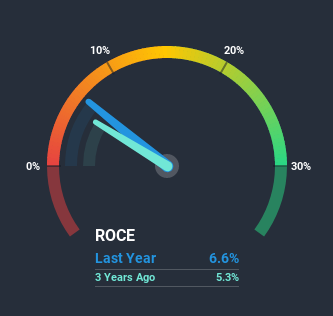- Hong Kong
- /
- Electronic Equipment and Components
- /
- SEHK:1480
Returns On Capital At Yan Tat Group Holdings (HKG:1480) Paint An Interesting Picture
There are a few key trends to look for if we want to identify the next multi-bagger. Ideally, a business will show two trends; firstly a growing return on capital employed (ROCE) and secondly, an increasing amount of capital employed. Ultimately, this demonstrates that it's a business that is reinvesting profits at increasing rates of return. However, after investigating Yan Tat Group Holdings (HKG:1480), we don't think it's current trends fit the mold of a multi-bagger.
Understanding Return On Capital Employed (ROCE)
If you haven't worked with ROCE before, it measures the 'return' (pre-tax profit) a company generates from capital employed in its business. To calculate this metric for Yan Tat Group Holdings, this is the formula:
Return on Capital Employed = Earnings Before Interest and Tax (EBIT) ÷ (Total Assets - Current Liabilities)
0.066 = HK$45m ÷ (HK$901m - HK$222m) (Based on the trailing twelve months to June 2020).
Thus, Yan Tat Group Holdings has an ROCE of 6.6%. On its own, that's a low figure but it's around the 8.1% average generated by the Electronic industry.
Check out our latest analysis for Yan Tat Group Holdings

Historical performance is a great place to start when researching a stock so above you can see the gauge for Yan Tat Group Holdings' ROCE against it's prior returns. If you want to delve into the historical earnings, revenue and cash flow of Yan Tat Group Holdings, check out these free graphs here.
What The Trend Of ROCE Can Tell Us
When we looked at the ROCE trend at Yan Tat Group Holdings, we didn't gain much confidence. Around five years ago the returns on capital were 10%, but since then they've fallen to 6.6%. And considering revenue has dropped while employing more capital, we'd be cautious. This could mean that the business is losing its competitive advantage or market share, because while more money is being put into ventures, it's actually producing a lower return - "less bang for their buck" per se.
On a related note, Yan Tat Group Holdings has decreased its current liabilities to 25% of total assets. That could partly explain why the ROCE has dropped. Effectively this means their suppliers or short-term creditors are funding less of the business, which reduces some elements of risk. Since the business is basically funding more of its operations with it's own money, you could argue this has made the business less efficient at generating ROCE.In Conclusion...
We're a bit apprehensive about Yan Tat Group Holdings because despite more capital being deployed in the business, returns on that capital and sales have both fallen. Long term shareholders who've owned the stock over the last five years have experienced a 37% depreciation in their investment, so it appears the market might not like these trends either. Unless there is a shift to a more positive trajectory in these metrics, we would look elsewhere.
If you want to continue researching Yan Tat Group Holdings, you might be interested to know about the 1 warning sign that our analysis has discovered.
If you want to search for solid companies with great earnings, check out this free list of companies with good balance sheets and impressive returns on equity.
When trading Yan Tat Group Holdings or any other investment, use the platform considered by many to be the Professional's Gateway to the Worlds Market, Interactive Brokers. You get the lowest-cost* trading on stocks, options, futures, forex, bonds and funds worldwide from a single integrated account. Promoted
New: Manage All Your Stock Portfolios in One Place
We've created the ultimate portfolio companion for stock investors, and it's free.
• Connect an unlimited number of Portfolios and see your total in one currency
• Be alerted to new Warning Signs or Risks via email or mobile
• Track the Fair Value of your stocks
This article by Simply Wall St is general in nature. It does not constitute a recommendation to buy or sell any stock, and does not take account of your objectives, or your financial situation. We aim to bring you long-term focused analysis driven by fundamental data. Note that our analysis may not factor in the latest price-sensitive company announcements or qualitative material. Simply Wall St has no position in any stocks mentioned.
*Interactive Brokers Rated Lowest Cost Broker by StockBrokers.com Annual Online Review 2020
Have feedback on this article? Concerned about the content? Get in touch with us directly. Alternatively, email editorial-team@simplywallst.com.
About SEHK:1480
Yan Tat Group Holdings
An investment holding company, manufactures and sells printed circuit boards.
Excellent balance sheet second-rate dividend payer.
Market Insights
Community Narratives



